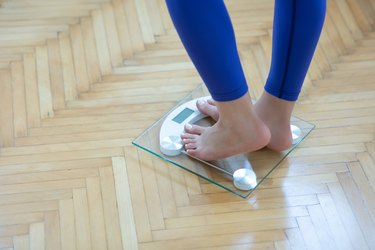
Lipid levels gotcha down — and need to literally come down? If your doctor has warned you that your triglycerides are too high, you're likely wondering how to quickly lower them. Here are three healthy and safe ways to lower those triglyceride levels.
Read more: Triglycerides: What You Need to Know
Video of the Day
Video of the Day
Make Healthy Diet Switches
High levels of triglycerides — a type of fat in your blood — can raise your risk of heart disease, according to Mayo Clinic, making it key to keep triglycerides in check. And to help bust high triglyceride levels, healthy lifestyle choices are crucial, Mayo Clinic says.
"Lifestyle-change therapies such as diet and exercise are not an overnight fix, but the good news is that triglycerides are very responsive to these lifestyle changes, and you can see a drop in triglycerides in a matter of days," says New York-based registered dietitian Katrina Hartog, MPH, RD, director of clinical nutrition at Mount Sinai West. "Furthermore, over the course of a year, intensive lifestyle strategies can reduce triglycerides by more than 50 percent."
Keeping a food diary and tackling areas in your diet such as sugar intake are good places to start, Hartog says. She says to "limit foods high in added sugar," like:
- Juice.
- Soda.
- Sweetened iced teas.
- Pastries.
- Cookies.
- Snack foods.
She also recommends reducing intake of such starchy foods and refined carbohydrates as:
- White bread.
- Certain cereals.
- Crackers.
- Noodles.
- White rice.
Instead, Hartog says, you'll want to incorporate carbohydrate foods with at least 2 grams of fiber per serving, such as:
- Brown rice.
- Whole wheat bread.
- Barley.
- Quinoa.
- Beans.
Fruits and vegetables are key food groups that can help lower triglycerides as well, Hartog says. "Have you heard of eating the rainbow? [There's] no time better than now to include color-rich fruits and vegetables," she says. "Aim for 2 to 3 cups of vegetables and 1 cup of fruit."
Choosing healthy sources of fat is also an important step in lowering triglycerides, according to Mayo Clinic.
Plant-based fats such as olive oil and canola oil are great substitutes for saturated fats found in meats, Mayo Clinic says. If you eat red meat, try swapping in fish like salmon and mackerel for dinner instead — both are high in heart-healthy omega-3 fatty acids, Mayo Clinic says.
According to Hartog, other healthy fat sources include:
- Avocados.
- Nuts.
- Olives.
Sweat to Shed Pounds
Mayo Clinic recommends regular exercise to help lower high triglycerides.
If you're already at a healthy weight, maintaining it is key, Hartog says. And if your doctor has informed you that you are overweight, you can shed some pounds through exercise, in addition to dietary changes. "A small weight loss of even 5 to 10 pounds can reduce triglyceride levels," Hartog says.
If you need to lose weight, the Centers for Disease Control and Prevention recommends pacing your weight loss and shedding 1 to 2 pounds per week for the best odds of keeping the weight off.
And adults should generally aim to get 150 minutes per week of aerobic exercise — physical activity that gets your heart pumping — at a moderate intensity, or 75 minutes per week at a vigorous intensity, according to the American Heart Association (AHA).
The AHA says that some activities that can ramp up your heart rate include:
- Brisk walking.
- Dancing.
- Running.
- Jumping rope.
- Swimming.
- Hiking uphill.
The AHA also suggests performing moderate- or high-intensity strength training activities at least twice per week (like weights or resistance).
Ask Your Doctor About Medication
But diet and exercise aren't always enough to lower high triglycerides, the Cleveland Clinic says. If your triglyceride levels still won't budge, you may need medication. The medication often chosen to treat high triglycerides is prescription statin therapy, the Cleveland Clinic says.
Other medications your doctor may order include prescription omega-3 fatty acid supplements — namely ones that include 2,000 and 4,000 milligrams of omega-3s called DHA + EPA, according to the Cleveland Clinic.
Cleveland Clinic recommends that you talk to your doctor about the risks and benefits of medication to lower triglyceride levels if you think you may need it, as well as any dietary and exercise changes you make.
Read more: What Do Rising or Falling Triglyceride Levels Mean?
- American Heart Association: “American Heart Association Recommendations for Physical Activity in Adults and Kids”
- Centers for Disease Control and Prevention: “Losing Weight”
- Cleveland Clinic: “Triglycerides & Heart Health”
- Katrina Hartog, MPH, RD, CDN, CHES, director of clinical nutrition, Mount Sinai West, New York
- Mayo Clinic: “Triglycerides: Why Do They Matter?”
Is this an emergency? If you are experiencing serious medical symptoms, please see the National Library of Medicine’s list of signs you need emergency medical attention or call 911.